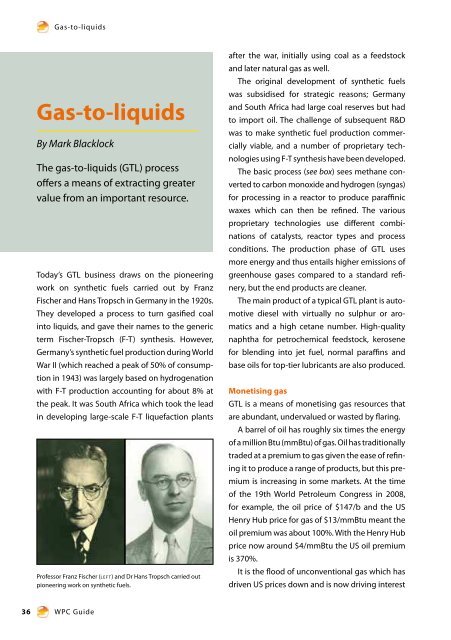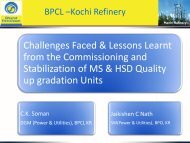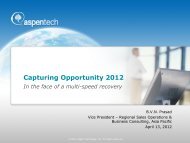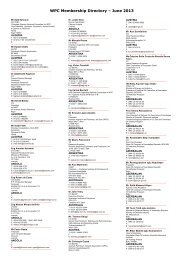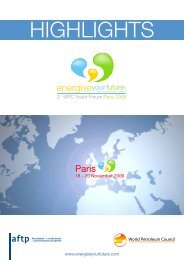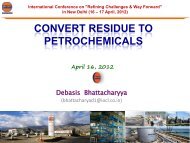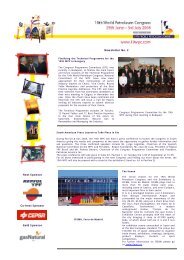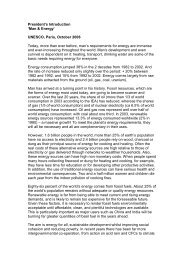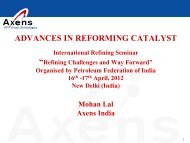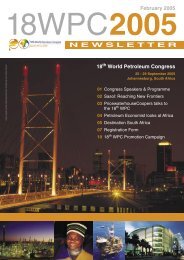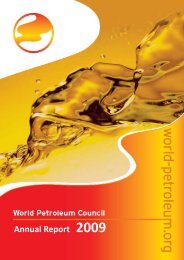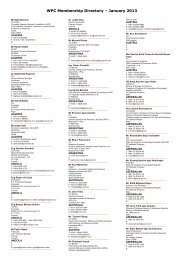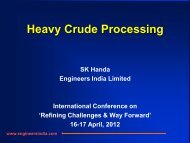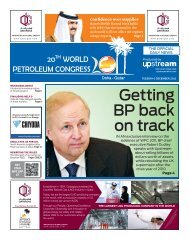pdf here - World Petroleum Council
pdf here - World Petroleum Council
pdf here - World Petroleum Council
Create successful ePaper yourself
Turn your PDF publications into a flip-book with our unique Google optimized e-Paper software.
Gas-to-liquids<br />
Gas-to-liquids<br />
after the war, initially using coal as a feedstock<br />
in developing GTL plants. Sasol is moving ahead<br />
the Escravos GTL plant being built by Chevron<br />
and later natural gas as well.<br />
with the front-end engineering and design (FEED)<br />
and the Nigerian National Petro leum Company<br />
The original development of synthetic fuels<br />
stage of Westlake GTL in Louisiana and is also<br />
will help the country eliminate flaring.<br />
Gas-to-liquids<br />
was subsidised for strategic reasons; Germany<br />
and South Africa had large coal reserves but had<br />
to import oil. The challenge of subsequent R&D<br />
looking at a GTL plant in western Canada. Both<br />
would use shale gas as a feed stock. Other companies<br />
are con sidering projects.<br />
Brazil also wants to avoid flaring associated gas.<br />
For its offshore oil fields Petrobras is evaluating a<br />
project to include a small GTL plant on floating,<br />
By Mark Blacklock<br />
was to make synthetic fuel production commercially<br />
viable, and a number of propri etary tech-<br />
For countries with abundant conventional gas<br />
resources, GTL is a way of providing high-quality<br />
production, storage and offloading (FPSO) vessels.<br />
This would produce a synthetic crude (syncrude)<br />
The gas-to-liquids (GTL) process<br />
offers a means of extracting greater<br />
value from an important resource.<br />
nologies using F-T synthesis have been developed.<br />
The basic process (see box) sees methane converted<br />
to carbon monoxide and hydrogen (syngas)<br />
for processing in a reactor to produce paraffinic<br />
waxes which can then be refined. The various<br />
products to the domestic market as well as extracting<br />
greater value from exports. Qatar Airways, for<br />
example, plans to fuel its aircraft with a 50:50<br />
blend of locally-produced GTL kerosene and conventional<br />
jet fuel. The resulting GTL jet fuel is not<br />
which would then be shipped with the main<br />
crude production to be refined elsew<strong>here</strong>.<br />
GTL plants around the world<br />
The first large-scale plants using gas as a feed-<br />
proprietary technologies use different combi-<br />
only cleaner but has a higher concentration of<br />
stock were commissioned in 1992 by Mossgas<br />
nations of catalysts, reactor types and process<br />
energy and weighs less than conventional jet fuel.<br />
(now part of Petro SA) in Mossel Bay, South Africa<br />
conditions. The production phase of GTL uses<br />
Flaring gas associated with oil production is<br />
(using Sasol’s advanced synthol process), and in<br />
more energy and thus entails higher emissions of<br />
polluting and wasteful. Nigeria is one of the mem-<br />
1993 by a Shell-led consortium in Bintulu,<br />
Today’s GTL business draws on the pioneer ing<br />
greenhouse gases compared to a standard refi-<br />
bers of the <strong>World</strong> Bank-led Global Gas Flaring<br />
Malaysia (using Shell middle distillate synthesis –<br />
work on synthetic fuels carried out by Franz<br />
nery, but the end products are cleaner.<br />
Reduction (GGFR) public-private par tner ship, and<br />
SMDS). The Malaysian plant suffered an explosion<br />
Fischer and Hans Tropsch in Germany in the 1920s.<br />
The main product of a typical GTL plant is auto-<br />
They developed a process to turn gasi fied coal<br />
into liquids, and gave their names to the generic<br />
motive diesel with virtually no sulphur or aromatics<br />
and a high cetane number. High-quality<br />
Processing of natural gas<br />
term Fischer-Tropsch (F-T) syn thesis. However,<br />
Germany’s synthetic fuel pro duction during <strong>World</strong><br />
naphtha for petrochemical feedstock, kerosene<br />
for blending into jet fuel, normal par a ffins and<br />
After raw natural gas has been treated, t<strong>here</strong> are<br />
three main operations in a gas-to-liquids plant.<br />
l Fluidised bed processes, in which syngas<br />
is passed rapidly at high temperatures through<br />
War II (which reached a peak of 50% of consumption<br />
in 1943) was largely based on hydrogenation<br />
with F-T pro duc tion accounting for about 8% at<br />
the peak. It was South Africa which took the lead<br />
in dev eloping large-scale F-T liquefaction plants<br />
base oils for top-tier lubricants are also produced.<br />
Monetising gas<br />
GTL is a means of monetising gas resources that<br />
are abundant, undervalued or wasted by flaring.<br />
A barrel of oil has roughly six times the energy<br />
of a million Btu (mmBtu) of gas. Oil has traditionally<br />
traded at a premium to gas given the ease of refining<br />
it to produce a range of products, but this premium<br />
is increasing in some markets. At the time<br />
of the 19th <strong>World</strong> <strong>Petroleum</strong> Congress in 2008,<br />
Firstly, synthesis gas (syngas) is produced. This is<br />
typically a combination of hydrogen and carbon<br />
monoxide in a ratio of 2:1, and four alternative<br />
methods are used:<br />
l Steam reforming of the feedstock in the<br />
presence of a catalyst.<br />
l Partial oxidation – oxygen is separated from<br />
nitrogen in a cryogenic air separation unit<br />
(ASU) and burned with natural gas at high<br />
temperatures and pressures. Alternatively, air<br />
may be used instead of pure oxygen.<br />
l Autothermal reforming, w<strong>here</strong> partial oxida tion<br />
a catalyst bed, such as the Sasol advanced<br />
synthol process. This uses an iron-based<br />
catalyst. It has been superseded by SPD in the<br />
international market.<br />
l Slurry processes, in which syngas is reacted in a<br />
slurry with a catalyst and molten wax<br />
(produced in the reactor), such as the Sasol<br />
slurry phase distillate (SPD) low-temperature<br />
process. This uses a cobalt-based catalyst.<br />
l Fixed bed processes, w<strong>here</strong> the syngas<br />
flows through tubes containing catalyst, such<br />
as Shell middle distillate synthesis (SMDS). This<br />
for example, the oil price of $147/b and the US<br />
is combined with steam reforming.<br />
uses a cobalt-based catalyst.<br />
Professor Franz Fischer (left) and Dr Hans Tropsch carried out<br />
pioneering work on synthetic fuels.<br />
Henry Hub price for gas of $13/mmBtu meant the<br />
oil premium was about 100%. With the Henry Hub<br />
price now around $4/mmBtu the US oil premium<br />
is 370%.<br />
It is the flood of unconventional gas which has<br />
driven US prices down and is now driving interest<br />
l Gas-heated reforming of natural gas with<br />
steam and oxygen.<br />
Then Fischer-Tropsch synthesis converts syngas<br />
into paraffinic hydrocarbons, a waxy synthetic<br />
crude. T<strong>here</strong> are three principal types of process:<br />
The synthetic crude is then converted<br />
into marketable petroleum products using<br />
conventional petrochemical upgrading processes,<br />
depending on the final slate of products required<br />
by the plant operator.<br />
36 WPC Guide<br />
Petrochemicals and Refining 37


